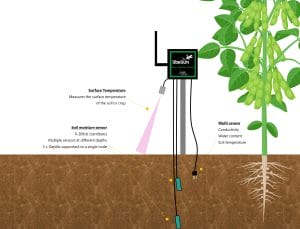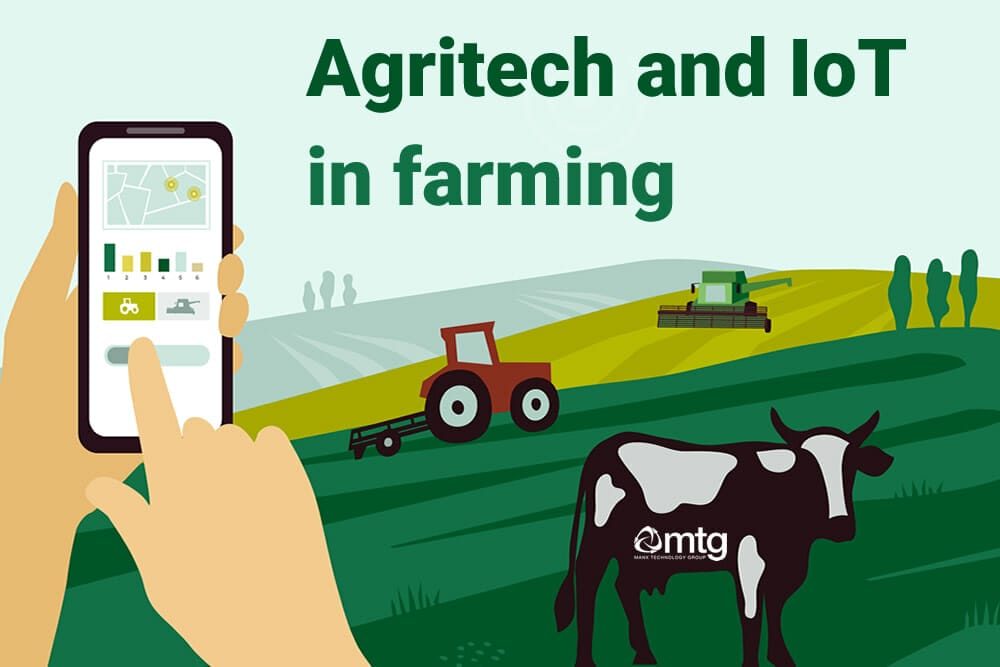Agricultural technology (agritech) aims to improve food production efficiency using technologies such as the Internet of Things (IoT), AI and Robotics. In this post, I explain the different pillars of agritech and highlight three key technologies.
Agritech Trends
 The World Government Summit in their report entitled ‘Agriculture 4.0 – The future of farming technology’ looks at three main trends that define agritech; new techniques, increasing efficiencies and the use of cross-industry technologies.
The World Government Summit in their report entitled ‘Agriculture 4.0 – The future of farming technology’ looks at three main trends that define agritech; new techniques, increasing efficiencies and the use of cross-industry technologies.
Out of the different pillars, Tech is perhaps the easiest to grasp and in many ways is the primary element that enables the newer techniques and helps farms develop efficiencies. From the technologies; Internet of Things and Data Analytics are two of the most established.
We already have customers who are actively deployment IoT but using the resultant data in data analytics and modelling. You can learn more about Smart Agriculture here.
- New techniques: Seawater farming, Algae feedstock, Bioplastics, Hydroponics, Desert agriculture.
- Improving Efficiencies: Precision farming, Vertical farming, Genomics, 3D Printing.
- Tech across industries: Internet of Things (IoT), Blockchain, Drones, Data analytics, Machine learning, AI, Crowdfarming.
Technology Focus

The same report highlights several Key technologies in the report include IoT, Blockchain and various emerging technologies. Most of our experience is in IoT, but we have worked on projects where Blockchain and another emerging tech (like AI) is being used extensively. We recommend that many of our clients use Microsoft Azure or Amazon AWS platforms for the simple reason they can scale their solution with ease and bolt-on services like AI, data modelling, etc.
- Internet of Things: Soil monitoring, Weather stations, Livestock tracking, Rumen monitoring, Asset management.
- Blockchain: Democratise, Provenance, Carbon footprint.
- Emerging tech: Artificial intelligence, machine learning, data analytics, modelling.
It is important to highlight these different technologies (which broadly equates to their adoption by farmers and food producers). Given the various challenges on the industry, Farmers are interested in technology unless it can positively impact their business.
Drones and IoT technology in farming is already widely adopted, with the technology becoming commonplace in the agricultural sector.
IoT in Agriculture
Manx Technology Group has many customers who are deploying IoT technology within the agricultural sector because it can enhance productivity and improve yields. The growing focus on the environmental impact of farming has also led many to use IoT and precision agriculture to optimise fertiliser, electricity, diesel, and water use.
I have highlighted some of the areas in which we have worked with our customers to deploy IoT.
- Soil Monitoring – Monitor soil oxygen levels and soil respiration.
- Smart Irrigation – Monitor soil moisture levels and soil water potential. Control irrigation systems and valves.
- Solar radiation (Photosynthetically active radiation) – the impact of PAR on plant or crop growth.
- Weather stations – Rainfall, wind, and sunlight.
- Gate monitoring – detect when gates are opened.
- Asset tracking – real-time location tracking of plant and farm machinery.
- Livestock tracking – location tracking and movement patterns of livestock
- Temperature & Humidity – the environmental conditions of cattle sheds, hen houses, and barns.
- Silo/Grain/Water levels – sensors to monitor water levels, grain siloes, and other storage containers.
Conclusion
Internet of Things (IoT) technology should be considered vital for the following types of organisations:
- Farm owner, or manager. If you are unsure about IoT, start with some basic deployments before seeing how the technology can be embraced more widely on the farm. We appreciate any technology is an investment. Therefore it should enable your business to make money, or save money – to justify the investment.
- Agricultural agency. IoT technology is recognised as a game-changer in farming, enabling those in the industry to improve productivity, reduce environmental impact, reduce costs and ensure competitiveness in the marketplace. As a responsible Agency, MTG can work with you to encourage technology trails, educate industry, and work on schemes that will promote the effective use of IoT in farming.
- Universities and colleges. If your educational establishment teaches agriculture or horticulture; the next generation of farmers should embrace IoT. MTG can work with you to provide solutions as part of your syllabus, or that reinforce learning. Consider a LoRaWAN network on your campus to support learning and facilitate R&D projects.
- Councils or development agencies. Consider deploying a LoRaWAN network in your area to provide a foundation for IoT deployments. Workshops and industry engagement for IoT are a great way of identifying latent needs and gaining the industry’s support for what is an exciting technology.
How can we help?
- Supply of sensors. MTG can supply a wide array of sensors that can be used in agricultural or agritech settings.
- Development of apps and portals. Our experience extends beyond hardware, our team of developers can write custom portals, databases and dashboards alongside the hardware.
- Networking. Low power networks provide a backbone for IoT deployments on farms. MTG can help design, supply, install and operate LoRaWAN networks that you can operate on your farm, or for several farms in a given area.
Find out more
If you would like to learn more about how MTG can work with you on your IoT projects, pricing on hardware and software, or to learn more about what we do – please get in touch.
You can reach our IoT team by submitting the Request a Quote form, e-mailing sales@mtg.im or calling +44 1624 777837.




